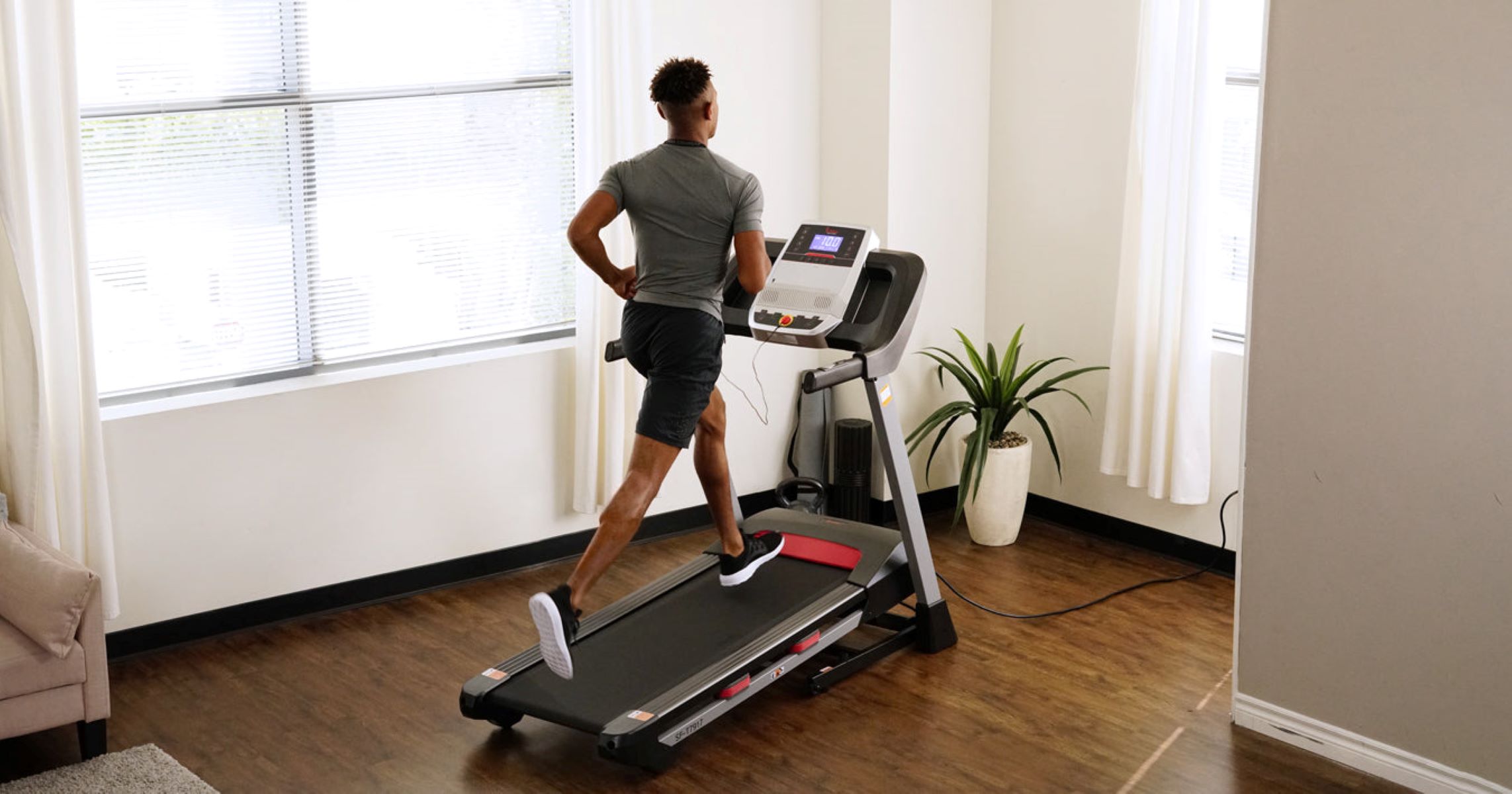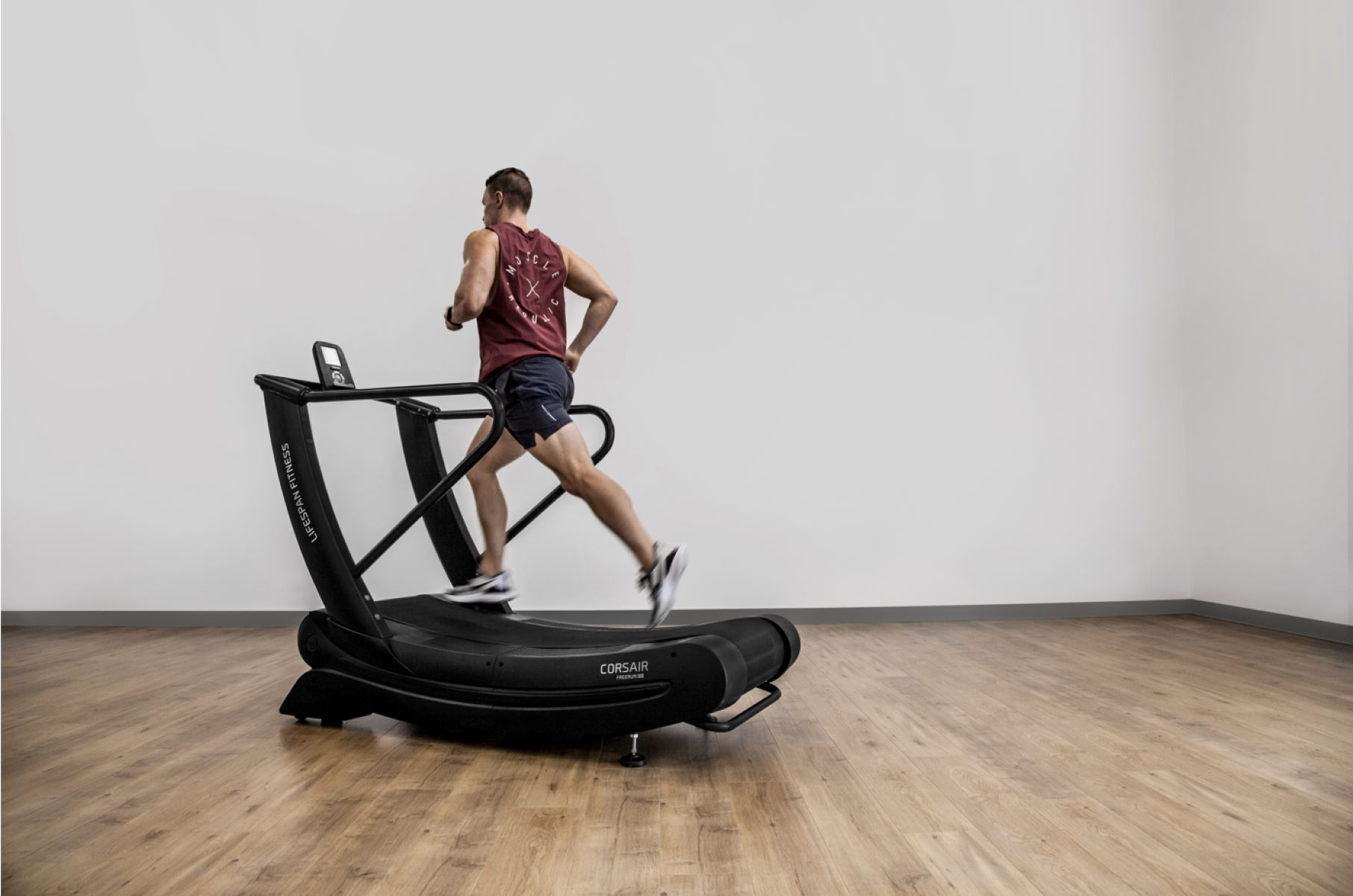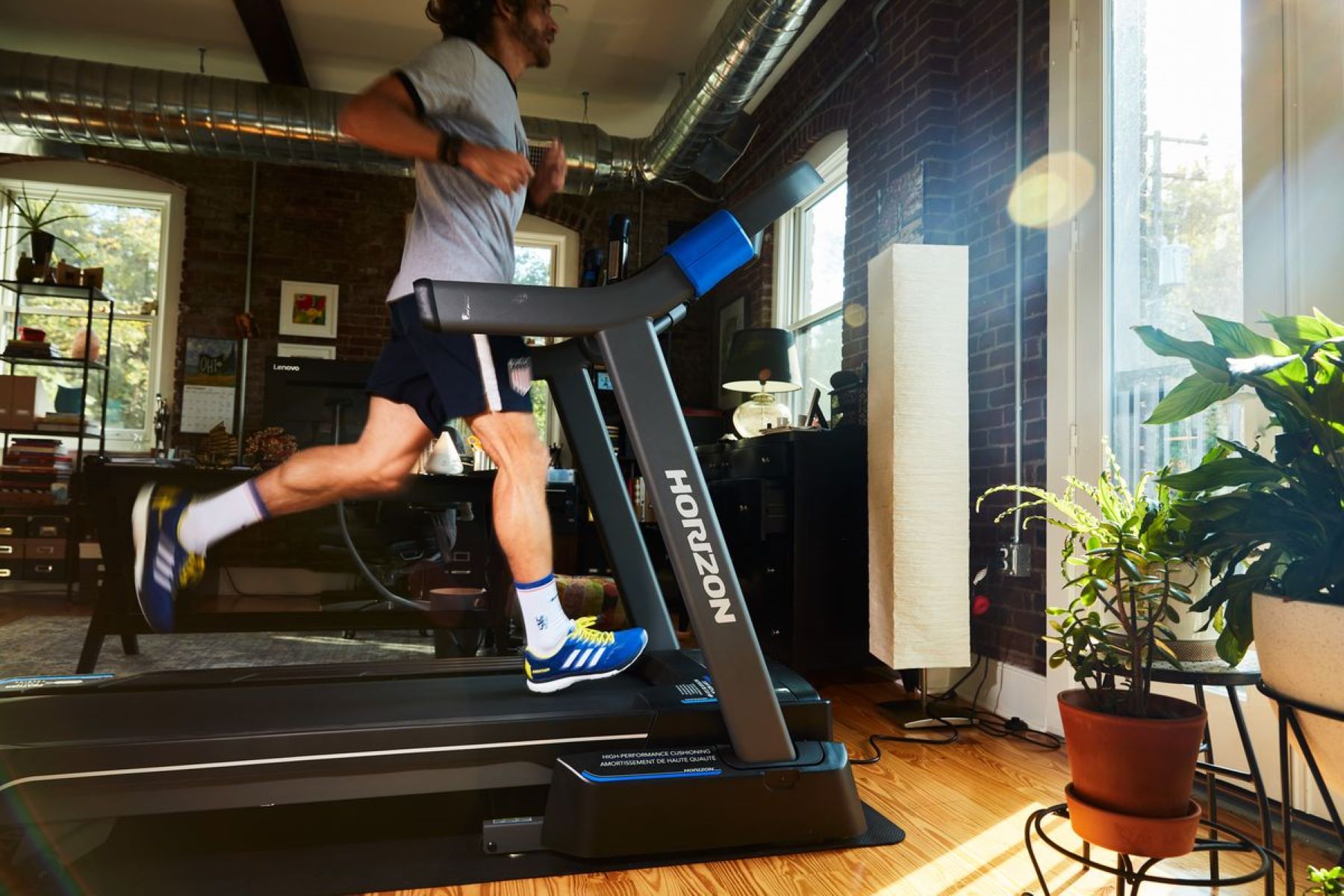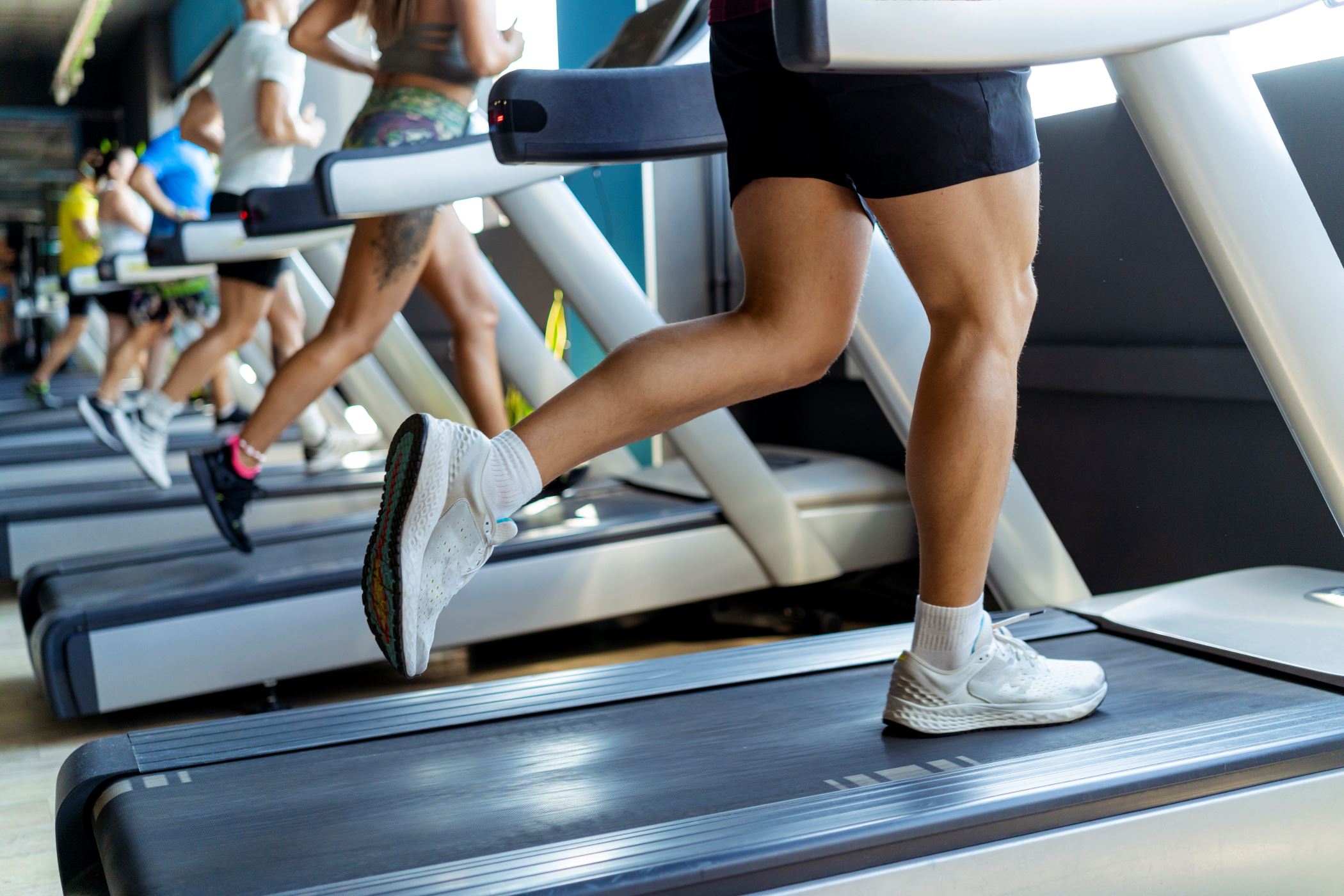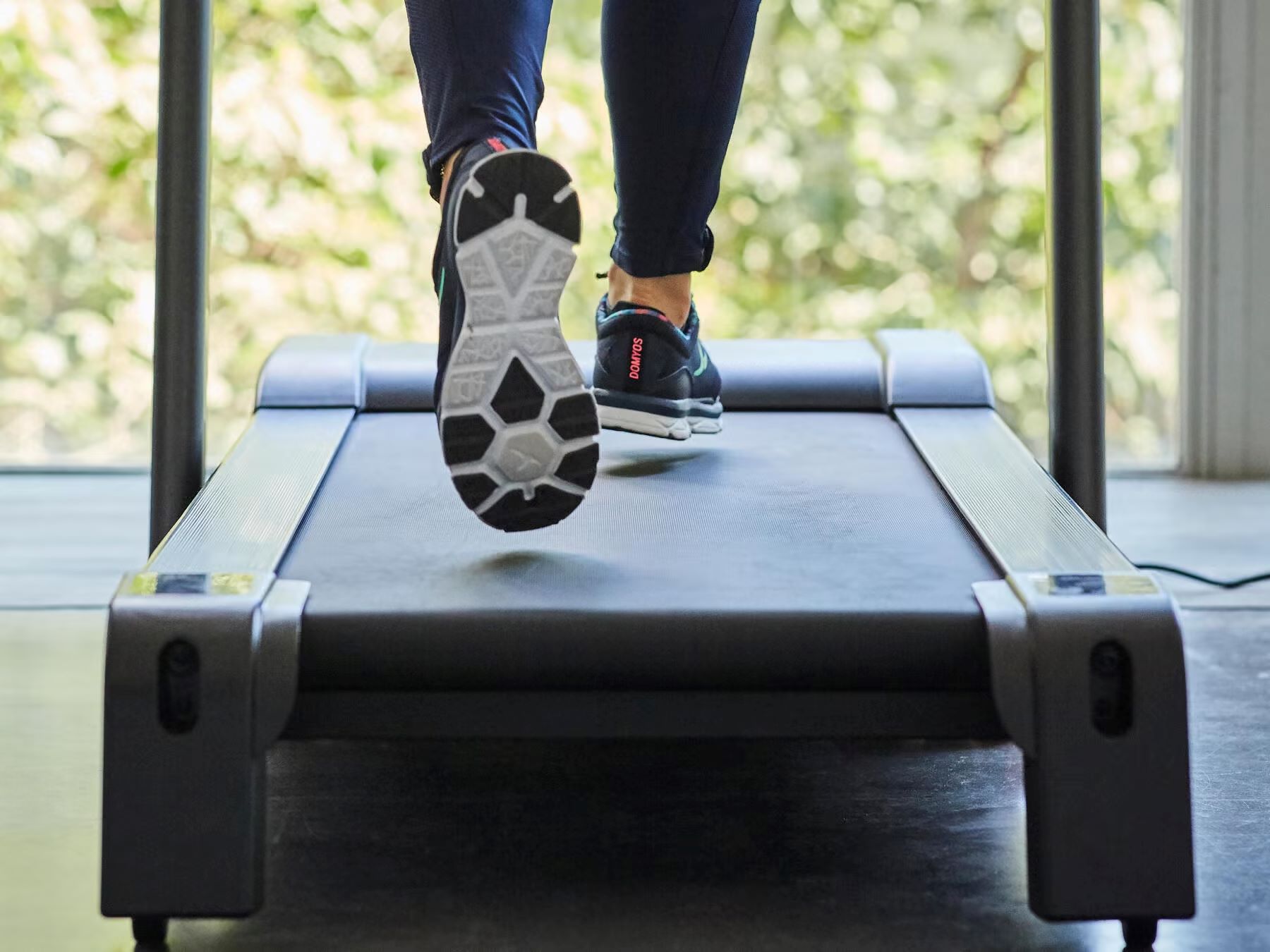

Featured
How To Get Faster On A Treadmill
Modified: March 2, 2024
"Discover the top tips and techniques to become faster on a treadmill. Learn from the experts and get featured in no time!"
Introduction
Welcome to the ultimate guide on how to get faster on a treadmill! Whether you are a beginner looking to improve your running speed or an experienced runner aiming to break your personal record, this article will provide you with valuable insights and tips to help you achieve your goals.
Running on a treadmill offers numerous benefits and is a convenient and efficient way to improve your cardiovascular fitness, endurance, and speed. Additionally, a treadmill allows you to control various factors such as pace, incline, and intensity, making it an excellent tool for targeted training.
Before we delve into the specific strategies to boost your speed on a treadmill, it’s important to have a basic understanding of how the treadmill works and how you can utilize its features to your advantage. Whether you have access to a commercial gym treadmill or you own one at home, knowing the ins and outs will enable you to tailor your training sessions to maximize your performance.
In the following sections, we will explore the various aspects of treadmill running that contribute to improving your speed. From setting the right pace and incorporating interval training, to utilizing incline settings and monitoring your heart rate, we will cover all the essential techniques and tips to help you get faster on a treadmill.
It’s important to note that getting faster on a treadmill requires consistency, dedication, and a progressive approach. This article will guide you through the entire process, from the initial warm-up to achieving your treadmill speed goals. So, lace up your running shoes, hop on the treadmill, and let’s get started on the exhilarating journey of improving your speed!
Benefits of Running on a Treadmill
Running on a treadmill offers a multitude of advantages that can greatly contribute to your overall fitness and speed. Whether you prefer to run indoors due to weather conditions, safety concerns, or simply for the convenience, here are some key benefits of running on a treadmill:
- Controlled Environment: One of the main benefits of running on a treadmill is the ability to control various environmental factors. You can set the temperature, adjust the incline and speed, and even simulate different terrains. This allows you to create optimal conditions for your training, ultimately improving your speed.
- Consistent Surface: Unlike outdoor running where you have to deal with uneven surfaces and potential hazards, treadmills provide a smooth and consistent running surface. This reduces the risk of injuries and allows you to focus solely on your running form and speed.
- Pace and Speed Control: Treadmills allow you to set and maintain a specific pace throughout your run. This is particularly useful when it comes to speed training, as you can gradually increase the speed over time to challenge your cardiovascular system and improve your running performance.
- Interval Training: Treadmills are excellent tools for interval training, which involves alternating between periods of high-intensity effort and recovery. By utilizing the treadmill’s speed and incline settings, you can easily incorporate interval workouts into your training routine, effectively boosting your running speed and stamina.
- Avoiding External Distractions: Running on a treadmill eliminates external distractions such as traffic, pedestrians, and other environmental factors that could hinder your focus and performance. This allows you to solely concentrate on your running technique and speed, maximizing your training session.
Furthermore, running on a treadmill provides a safe and controlled environment for individuals with joint issues or recovering from injuries. The cushioned surface of the treadmill reduces the impact on your joints, making it a more comfortable option for those with physical limitations.
It’s important to mention that while running outdoors offers its own unique benefits and challenges, incorporating treadmill running into your training routine can complement your outdoor runs and offer specific advantages for improving your speed. By utilizing the benefits of running on a treadmill, you can enhance your performance, increase your endurance, and ultimately get faster.
Understanding Your Treadmill
Before you begin your treadmill training to improve your speed, it’s essential to understand the different features and settings of your treadmill. Familiarizing yourself with these aspects will allow you to optimize your running experience and make effective adjustments during your workouts. Here are some key elements to consider:
- Speed Control: The speed control feature on your treadmill allows you to adjust the pace at which the belt moves. It is typically measured in miles per hour (mph) or kilometers per hour (km/h). Knowing how to adjust and fine-tune the speed settings will help you maintain your desired pace and gradually increase your speed over time.
- Incline Settings: Most treadmills offer incline settings that allow you to simulate running uphills. By adjusting the incline, you can target different muscle groups, increase the intensity of your workouts, and improve your overall strength and speed.
- Pre-Set Programs: Many treadmills come with pre-set workout programs designed to target specific goals, such as endurance, fat burning, or interval training. Exploring and utilizing these programs can add variety and structure to your training, pushing you to new levels of speed and performance.
- Heart Rate Monitoring: Some treadmills are equipped with heart rate monitors that track your heart rate during your workouts. Monitoring your heart rate can help you gauge your effort level and ensure you are training within the appropriate intensity zone for your goals.
- Cushioning: The cushioning system on a treadmill affects the impact absorption, making your runs more comfortable and reducing the stress on your joints. Understanding the level of cushioning on your treadmill can help you choose a setting that suits your preferences and provides the right balance between support and responsiveness.
- Safety Features: Familiarize yourself with the emergency stop button or safety key on your treadmill. These features are essential in case of any accidents or if you need to immediately stop the treadmill in an emergency to prevent injury.
Take the time to read the user manual and explore the different settings and features of your specific treadmill model. This knowledge will empower you to utilize the treadmill effectively, customize your workouts, and make necessary adjustments to enhance your speed training.
Regular maintenance and calibration of your treadmill are also crucial for accurate speed and incline readings. Make sure to follow the manufacturer’s guidelines for maintenance and periodically check the accuracy of the treadmill’s readings.
Understanding your treadmill and its various features will enable you to optimize your training sessions, tailor your workouts to your specific goals, and make the most of your treadmill runs as you strive to get faster.
Proper Warm-Up and Cool-Down
Performing a proper warm-up and cool-down is essential for any workout, including treadmill running. These pre and post-run routines help prepare your body for the upcoming exercise and aid in recovery. Here’s why warm-up and cool-down are important and how to do them effectively:
Warm-Up: Before starting your treadmill run, a dynamic warm-up routine is crucial to increase blood flow to your muscles, improve flexibility, and prepare your body for the upcoming intensity. A warm-up should consist of dynamic stretches and movements that target the major muscle groups involved in running, such as your legs, hips, and core. This can include exercises like leg swings, lunges, high knees, and arm circles. Start with low intensity and gradually increase the range of motion and speed of the movements.
The warm-up should last at least 5-10 minutes and gradually prepare your cardiovascular system for the workout ahead. It primes your muscles, lubricates your joints, and mentally prepares you for the run, reducing the risk of injuries and improving your overall performance on the treadmill.
Cool-Down: After completing your treadmill run, it’s equally important to allow your body to gradually recover and bring your heart rate back to its resting state. A proper cool-down routine enhances the recovery process and reduces muscle soreness. It should include gentle cardio exercises such as walking or slow jogging at a reduced pace, followed by static stretching for the major muscle groups used during the run.
During the cool-down, focus on taking deep breaths, relaxing your muscles, and allowing your body to gradually return to a state of rest. This helps remove waste products, such as lactic acid, from your muscles and promotes efficient recovery.
Both the warm-up and cool-down should not be rushed. Take the time to properly warm up your body before hopping on the treadmill and dedicate a few minutes for a thorough cool-down at the end of your run. By incorporating these routines into your treadmill workouts, you’ll reduce the risk of injuries, minimize post-run soreness, and promote overall better performance.
Remember, warming up and cooling down are just as important for your treadmill runs as the actual run itself. Treat these routines with the same level of importance to ensure a safe and effective running experience on the treadmill.
Setting Your Pace
Setting the right pace on the treadmill is crucial for improving your speed and achieving your running goals. Your pace refers to the speed at which you run, measured in miles per hour (mph) or kilometers per hour (km/h). Here’s how to determine and set your ideal pace:
1. Assess Your Current Fitness Level: Before setting your pace, it’s important to assess your current fitness level. Consider factors such as your endurance, previous running experience, and any recent improvements in your speed. This self-assessment will help you establish a baseline for your pace and set realistic goals to work towards.
2. Start Slower Than Your Comfort Zone: In order to increase your speed, it’s essential to push yourself outside of your comfort zone. Begin your runs at a slightly slower pace than what feels comfortable. This will allow your body to adapt and gradually build up endurance. As you gain more confidence and strength, you can gradually increase the speed to challenge yourself further.
3. Use the Talk Test: A simple way to determine if you’re running at the right pace is to use the talk test. While running, you should be able to carry on a conversation without gasping for breath. If you can’t speak in full sentences, it’s an indication that you’re running too fast and need to slow down. On the other hand, if you’re able to speak effortlessly, you may consider increasing your pace for more intensity.
4. Gradually Increase Your Speed: As you become more comfortable with your pace, gradually increase the speed in small increments. The key is to make progressive changes to avoid overwhelming your body and risking injury. By consistently challenging yourself with small speed increases, you’ll steadily improve your running speed over time.
5. Utilize Interval Training: Incorporating interval training into your treadmill runs is an effective way to boost your speed. Alternate between periods of high-intensity sprints and recovery intervals at a slower pace. This interval training will not only improve your cardiovascular fitness but also help you develop speed and endurance.
6. Listen to Your Body: It’s important to listen to your body and adjust your pace accordingly. If you’re feeling fatigued, it’s okay to decrease the speed or take a short break. Pushing yourself too hard without adequate rest can lead to overtraining and potential injuries. Find a balance between pushing your limits and allowing for proper recovery.
Remember, setting your pace is a gradual process that requires patience and consistency. Be mindful of your current fitness level, use the talk test as a guideline, and gradually increase your speed over time. By finding the right pace, you’ll effectively improve your speed, endurance, and overall treadmill running performance.
Incorporating Interval Training
Interval training is a highly effective method to improve your speed on a treadmill. By alternating between periods of high-intensity effort and recovery, interval training challenges your cardiovascular system, increases your endurance, and helps you develop speed. Here’s how to incorporate interval training into your treadmill workouts:
1. Determine Your Work and Rest Intervals: Start by determining the length of your work and rest intervals. Work intervals should be challenging but sustainable, while rest intervals allow for recovery. As a beginner, you may start with shorter work intervals, such as 30 seconds, and longer rest intervals, around 1 minute. As you progress, gradually increase the work interval lengths and decrease the rest interval lengths.
2. Gradually Increase Intensity: Begin with a warm-up at an easy pace for 5-10 minutes. Then, increase the speed to the desired intensity for the work interval. Aim to run at a fast pace, pushing yourself just below your maximum effort. Once the work interval is complete, decrease the speed or walk at a comfortable pace for the recovery interval.
3. Repeat the Intervals: Repeat the work and recovery intervals for a set number of repetitions or a specified time. As you progress, you can gradually increase the number of repetitions or the duration of the intervals to continue challenging yourself.
4. Experiment with Incline: To further intensify your interval training, incorporate incline settings on your treadmill. Running at an incline simulates uphill running and engages different muscle groups. Start with a moderate incline and gradually increase it as you progress. This will not only improve your speed but also enhance your overall running strength and endurance.
5. Track Your Progress: Keep a record of your interval training sessions to track your progress over time. Note the distances, speeds, and times for each interval workout. This will allow you to monitor your improvements and adjust your training as needed.
6. Stay Consistent: Consistency is key when incorporating interval training into your treadmill workouts. Aim for at least two interval training sessions per week, allowing for rest days in between. This will give your body sufficient time to recover and adapt to the high-intensity intervals.
Interval training not only improves your speed on the treadmill but also has a positive impact on your overall fitness and performance. It challenges your body in different ways and keeps your workouts engaging and varied.
Remember to include a proper warm-up and cool-down before and after your interval training sessions to reduce the risk of injury and promote recovery. By incorporating interval training into your treadmill workouts, you’ll see significant improvements in your speed, endurance, and overall running performance.
Utilizing Incline Settings
When it comes to improving your speed on a treadmill, utilizing the incline settings can be a game-changer. Running at an incline helps to mimic the challenge of outdoor running and engages various muscle groups, ultimately improving your overall strength and speed. Here’s how to effectively utilize the incline settings on your treadmill:
1. Start with a Moderate Incline: If you’re new to using incline settings, start with a moderate incline of around 2-3%. This slight elevation will already make a noticeable difference in your workout, engaging your lower body muscles and increasing the intensity of your run.
2. Gradually Increase the Incline: As you become more comfortable, gradually increase the incline to further challenge yourself. Try adding increments of 1-2% at a time until you reach a level that pushes your limits but is still manageable. Adjust the incline according to your fitness level and goals.
3. Use Incline for Specific Training: In addition to increasing overall speed, you can also use incline settings for specific training purposes. For instance, if you’re training for a hilly race, incorporate steeper inclines to simulate uphill running. This will help prepare your body for the demands of the race and improve your hill-climbing ability.
4. Alternate Between Incline and Flat Running: Integrate intervals of incline running with flat running during your workout. This combination will enhance your overall running performance and provide a balanced training effect. For example, you can perform 1-2 minutes of running at an incline, followed by the same amount of time at a flat or slightly declined setting. This helps to target different muscle groups and develop speed and endurance.
5. Monitor Your Form: When running at an incline, pay attention to your form. Lean slightly forward from your ankles to maintain balance and engage your core muscles. Keep your stride length and cadence consistent to ensure efficient and effective running mechanics.
6. Regularly Mix Incline Workouts with Flat Runs: While utilizing incline settings is beneficial, it’s essential to mix in workouts with flat runs as well. This helps to maintain a balanced training routine and reduce the risk of overuse injuries. Alternate between incline workouts and flat runs to continue challenging your body while allowing for proper recovery.
7. Prioritize Safety and Comfort: Always prioritize your safety and comfort when using incline settings. Make sure your treadmill is stable and secure, especially at higher incline levels. If you feel any discomfort or excessive strain, decrease the incline or adjust your pace accordingly. Listen to your body and make adjustments as needed.
Remember, incorporating incline settings into your treadmill workouts is an effective way to improve your speed, enhance your running form, and build lower body strength. By gradually increasing the incline and mixing in incline workouts with flat runs, you’ll see significant improvements in your overall treadmill performance and outdoor running abilities.
Monitoring Your Heart Rate
Monitoring your heart rate during treadmill workouts is an important aspect of improving your speed and optimizing your training. Your heart rate is a reliable indicator of the intensity at which you are exercising and can help you gauge your effort level. Here’s why and how to monitor your heart rate during treadmill runs:
1. Understanding Heart Rate Zones: Each individual has different heart rate zones that correspond to specific training intensities. These zones are typically defined as a percentage of your maximum heart rate (MHR). The five commonly recognized heart rate zones are:
- Zone 1 – Very light intensity: 50-60% of MHR
- Zone 2 – Light intensity: 60-70% of MHR
- Zone 3 – Moderate intensity: 70-80% of MHR
- Zone 4 – Hard intensity: 80-90% of MHR
- Zone 5 – Maximum intensity: 90-100% of MHR
2. Determine Your Maximum Heart Rate: To monitor your heart rate accurately, it’s helpful to determine your maximum heart rate. An estimated formula commonly used is 220 minus your age. However, keep in mind that this is a general estimation and individual variations may exist. Consulting with a healthcare professional or undergoing a fitness assessment can provide a more accurate measurement of your maximum heart rate.
3. Use a Heart Rate Monitor: A heart rate monitor, such as a chest strap monitor or a fitness watch with built-in heart rate monitoring, is a convenient tool to track your heart rate during treadmill runs. These devices provide real-time data, allowing you to stay within your desired heart rate zone and adjust your pace or incline accordingly.
4. Set Training Goals Based on Heart Rate: By understanding the various heart rate zones, you can set specific training goals based on the intensity you want to achieve. For example, if you’re focusing on endurance, you may aim to stay within Zone 3. If you’re targeting speed and interval training, you might challenge yourself to reach Zone 4 during intense efforts.
5. Monitor Progress and Recovery: Tracking your heart rate during treadmill runs helps you monitor progress over time. As your cardiovascular fitness improves, you may notice that you can sustain higher heart rates for longer periods or reach higher zones with less effort. Additionally, your heart rate during recovery periods can indicate how effectively your body is recovering between intervals or workouts.
6. Listen to Your Body: While heart rate monitoring is a useful tool in your training, it’s important to listen to your body as well. Factors such as fatigue, stress, and other external conditions can affect your heart rate response. If you feel excessively fatigued or experience any abnormal symptoms, adjust your workout accordingly and consult with a healthcare professional if needed.
Monitoring your heart rate during treadmill workouts allows you to train at the right intensity for your goals and ensure that you are not overexerting or underperforming. By incorporating heart rate monitoring into your training routine, you can optimize your speed, endurance, and overall treadmill running performance.
Maintaining Proper Form
Maintaining proper form while running on a treadmill is essential for enhancing your speed, preventing injuries, and improving overall efficiency. Running with proper form ensures that your muscles are working in harmony, reduces unnecessary strain, and allows you to maintain a consistent stride. Here are some key aspects to focus on to maintain proper form:
1. Posture: Stand tall with a slight forward lean. Avoid slouching or leaning backward, as this can throw off your balance and make your running less efficient. Engage your core muscles to maintain stability and proper alignment throughout your run.
2. Head and Neck Position: Keep your head up, looking straight ahead, and not down at your feet. Relax your neck and avoid unnecessary tension. This helps maintain a neutral spine alignment and allows for better airflow during your run.
3. Arm Swing: Your arms play a crucial role in maintaining balance and momentum while running. Bend your elbows at approximately a 90-degree angle and allow your arms to swing naturally back and forth. Avoid excessive arm movements, crossing your arms over your body, or swinging them too far out to the side.
4. Footstrike: Aim to land with a midfoot or forefoot strike, rather than striking with your heel. This encourages a smooth and efficient transition from landing to pushing off. The midfoot strike allows for better shock absorption and reduces the impact on your joints.
5. Cadence: Maintain a quick and consistent cadence, which refers to the number of steps per minute. Aiming for a cadence of around 170-180 steps per minute is generally recommended, as it promotes a more efficient running stride and reduces the risk of overstriding.
6. Breathing: Pay attention to your breathing pattern during your run. Breathe deeply and rhythmically, inhaling through your nose and exhaling through your mouth. This helps oxygenate your muscles and reduce feelings of fatigue.
7. Balance and Stability: Avoid excessive side-to-side or lateral movements. Maintain a stable and controlled stride, engaging your core and focusing on landing and pushing off evenly on both feet. Strengthening your core and incorporating balance exercises into your training routine can help improve your stability.
8. Listen to Your Body: Every individual is unique, and it’s important to listen to your body. Adjust your form to what feels natural and comfortable for you. If you experience pain or discomfort, particularly in your joints or muscles, evaluate your form and make necessary adjustments or seek professional guidance from a running coach or physical therapist.
By maintaining proper form while running on a treadmill, you’ll optimize your speed, reduce the risk of injuries, and maximize the efficiency of your workouts. Practice these form guidelines during your treadmill runs to develop good habits that will carry over to your outdoor running as well.
Avoiding Common Mistakes
When aiming to improve your speed on a treadmill, it’s important to be aware of common mistakes that can hinder your progress and increase the risk of injuries. By avoiding these mistakes, you’ll be able to maximize your training potential and achieve your running goals. Here are some common mistakes to watch out for:
1. Overstriding: Overstriding occurs when your foot lands too far in front of your body, leading to unnecessary braking forces and inefficient movement. Strive for a midfoot or forefoot strike, allowing your foot to land closer to your body’s center of mass for a more efficient stride and reduced risk of injury.
2. Holding onto the Treadmill: Using the handrails or gripping onto the treadmill console can disrupt your natural running mechanics and decrease the intensity of your workout. Keep your hands to your sides or lightly rest them on the front handles to maintain balance, but avoid relying on them for support.
3. Incorrect Foot Placement: Ensure that your feet are centered on the treadmill belt. Placing your feet too close to the front or back can destabilize your stride and increase the risk of tripping or losing balance.
4. Neglecting Proper Warm-Up and Cool-Down: Skipping or rushing through your warm-up and cool-down can increase the chance of muscle soreness, stiffness, and injury. Allocate sufficient time for both to prepare your body for the workout and aid in recovery.
5. Not Using the Incline: Neglecting to utilize the incline feature on the treadmill means missing out on an opportunity to enhance your running strength and endurance. Incorporating incline settings can help simulate outdoor running conditions and prepare you for various terrains.
6. Ignoring Warning Signs of Fatigue or Pain: Pushing through excessive fatigue or ignoring pain can lead to overtraining and potential injuries. Listen to your body and adjust your pace or take rest days as needed. It’s better to address any discomfort early on than to risk long-term setbacks.
7. Lack of Variation in Workouts: Repeating the same workout routine without variation can lead to plateauing and boredom. Incorporate different types of workouts, such as interval training, tempo runs, or hill workouts, to challenge yourself and keep your training stimulating.
8. Incorrect Treadmill Settings: Ensure that your treadmill settings, including speed and incline, are accurately set. Using incorrect settings can affect your perception of effort and hinder your progress. Familiarize yourself with the controls and regularly calibrate your machine for accurate readings.
9. Neglecting Recovery and Rest: Allowing adequate rest and recovery is crucial for optimal performance. Overtraining can lead to decreased speed, increased risk of injury, and diminished motivation. Listen to your body’s need for rest days and incorporate active recovery exercises into your routine.
Avoiding these common mistakes will help you optimize your training, improve your speed, and reduce the risk of injuries. By being mindful of your form, training intensity, and recovery, you’ll be able to achieve your goals effectively and enjoy the benefits of treadmill running.
Staying Motivated
Staying motivated is key to consistently working towards improving your speed on a treadmill. From setting goals to finding ways to keep your workouts engaging, maintaining motivation will help you stay on track and reap the rewards of your efforts. Here are some strategies to stay motivated along your journey:
1. Set Realistic and Attainable Goals: Establish clear and realistic goals that are specific, measurable, and time-bound. Whether it’s beating a previous personal record, increasing your average speed, or completing a certain distance within a set time, having tangible targets gives you something to strive for and measure your progress against.
2. Track Your Progress: Keep a record of your runs, including distance covered, average speed, and any noteworthy achievements. Seeing your improvement over time can be incredibly motivating and satisfying. Use a running app, a fitness tracker, or simply a dedicated journal to track your progress and celebrate your accomplishments along the way.
3. Vary Your Workouts: Monotony can quickly lead to boredom and decreased motivation. Add variety to your workouts by incorporating different types of runs, such as interval training, hill workouts, or tempo runs. Trying new routes, listening to motivational music or podcasts, or joining virtual running challenges can also add excitement and keep your workouts engaging.
4. Find an Accountability Partner: Partnering up with a friend, family member, or running group can be a great way to stay motivated and accountable. Share your goals, plan workouts, and support each other along the way. Knowing that someone is counting on you can provide the extra push you need to stay committed to your training.
5. Reward Yourself: Set up a system of rewards for reaching milestones or accomplishing specific goals. Treat yourself to something you enjoy, whether it’s a relaxing massage, new running gear, or a favorite indulgence. Having an incentive to work towards can make even the toughest workouts more rewarding.
6. Visualize Success: Take a few moments before your treadmill runs to visualize yourself achieving your speed goals. Imagine the feeling of accomplishment, the sense of pride, and the sense of empowerment that comes with improving your speed. Visualizing success can boost your motivation and mental focus during your workouts.
7. Mix Up Your Training Environment: If possible, incorporate outdoor runs into your training routine. Running in different locations and enjoying the beauty of nature can rejuvenate your motivation. The change of scenery and fresh air can provide a welcome break from indoor treadmill workouts.
8. Practice Positive Self-Talk: Replace negative thoughts or self-doubt with positive affirmations. Encourage yourself, remind yourself of your progress, and focus on the reasons why you started this journey in the first place. Positive self-talk can shift your mindset and fuel your motivation to keep pushing forward.
9. Prioritize Self-Care: Taking care of your body and mind is essential for long-term motivation. Get adequate rest, fuel your body with nutritious food, and prioritize recovery. Treat yourself to regular rest days, indulge in relaxing activities, and listen to your body’s needs to prevent burnout and stay motivated in the long run.
Remember, motivation can fluctuate, so it’s important to be patient and kind to yourself during times when it feels challenging. Incorporate these strategies into your training routine, find what works best for you, and keep your eyes on the prize – your improved speed and overall running success on the treadmill.
Conclusion
Congratulations on completing this comprehensive guide on how to get faster on a treadmill! By incorporating the strategies and techniques discussed throughout this article, you are well-equipped to improve your speed, endurance, and overall performance on the treadmill.
From understanding your treadmill and setting the right pace to incorporating interval training and utilizing incline settings, you now have a diverse toolkit to enhance your speed workouts. Monitoring your heart rate, maintaining proper form, and avoiding common mistakes will further contribute to your progress and minimize the risk of injuries.
Additionally, staying motivated and committed to your training is essential for long-term success. Set realistic goals, track your progress, and find ways to keep your workouts engaging and enjoyable. Remember, consistency is key, and progress takes time. Trust in the process and celebrate each milestone along the way.
Whether you are a seasoned runner or just starting your running journey, improving your speed on a treadmill is an achievable goal. With dedication, patience, and the strategies outlined in this guide, you will unlock your full potential and continue to progress as a runner.
So, lace up your running shoes, hop on the treadmill, and embark on the exhilarating journey of getting faster. Embrace the challenges, build your speed, and enjoy the rewards of your hard work. The road to becoming a faster runner starts with that first step on the treadmill.


